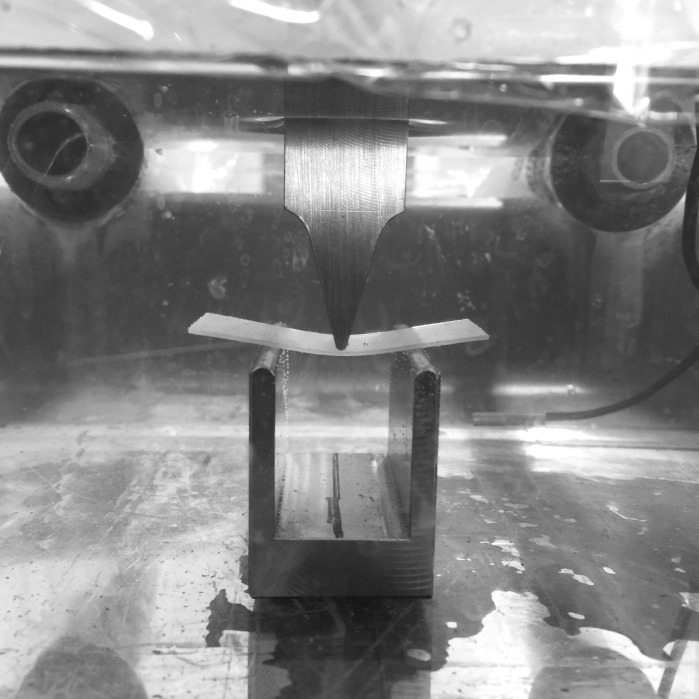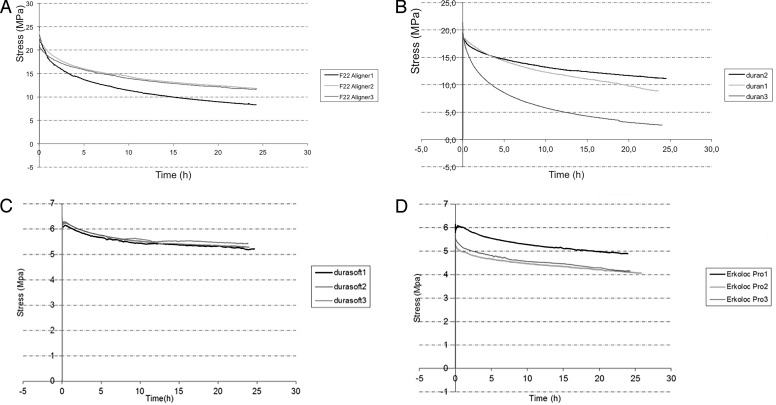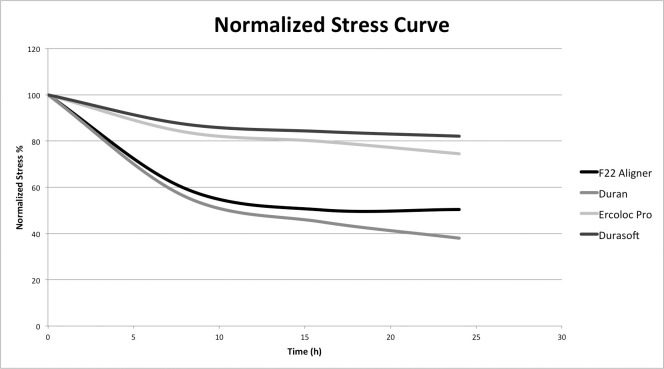Abstract
Objective:
To investigate the stress release properties of four thermoplastic materials used to make orthodontic aligners when subjected to 24 consecutive hours of deflection.
Materials and Methods:
Four types of aligner materials (two single and two double layered) were selected. After initial yield strength testing to characterize the materials, each sample was subjected to a constant load for 24 hours in a moist, temperature-regulated environment, and the stress release over time was measured. The test was performed three times on each type of material.
Results:
All polymers analyzed released a significant amount of stress during the 24-hour period. Stress release was greater during the first 8 hours, reaching a plateau that generally remained constant. The single-layer materials, F22 Aligner polyurethane (Sweden & Martina, Due Carrare, Padova, Italy) and Duran polyethylene terephthalate glycol-modified (SCHEU, Iserlohn, Germany), exhibited the greatest values for both absolute stress and stress decay speed. The double-layer materials, Erkoloc-Pro (Erkodent, Pfalzgrafenweiler, Germany) and Durasoft (SCHEU), exhibited very constant stress release, but at absolute values up to four times lower than the single-layer samples tested.
Conclusions:
Orthodontic aligner performance is strongly influenced by the material of their construction. Stress release, which may exceed 50% of the initial stress value in the early hours of wear, may cause significant changes in the behavior of the polymers at 24 hours from the application of orthodontic loads, which may influence programmed tooth movement.
Keywords: Stress release, Orthodontic aligners, Thermoplastic materials, F22 Aligner
INTRODUCTION
The ever-increasing demand for esthetic, unobtrusive orthodontics has fueled an exponential growth in the clear aligner industry.1 Clear aligners are also advantageous in that they are removable, tailor-made in sequence on patient-specific malocclusion setups, and capable of progressively guiding teeth into their programmed positions.2–4 However, not every aligner is created equal, and those currently on the market differ in terms of their construction material, thickness, and clinical protocol.
The first mass-marketed aligners, commercialized by the multinational Align Technology (San Jose, Calif), were made out of a single-layer rigid polyurethane obtained from methylene diphenyl diisocyanate and 1,6-hexanediol. Subsequent incarnations were formed from Exceed-30 (Align Technology), designed for its improved flexibility, breakage resistance, and transparency. This was also superseded in 2012 by SmartTrack® (Align Technology), a thermoplastic polyurethane that, according to the firm, should be able to meet the need for lighter, more constant forces, as well as a greater elasticity, which should make orthodontic movements more predictable.5
The majority of other aligner manufacturers currently rely on polyethylene terephthalate glycol-modified (PET-G), but polypropylene, polycarbonate (PC), thermoplastic polyurethanes (TPU), ethylene vinyl acetate, and many other materials are used.6
Clear aligners also come in a range of different thicknesses, from 0.50 mm to 1.5 mm.7 Similar to their construction material, this can affect their mechanical properties and therefore their performance. In an ideal world, to provide physiological movement of the teeth clear aligners should be able to exert constant light forces throughout their use, but this, in reality, is difficult to achieve.8
Indeed, the plastic materials used in removable aligners have very different properties with respect to the metals used to perform the same function in fixed orthodontics. Orthodontists are familiar with the elastic properties of Nitinol and steel archwires, which exert forces proportional to their deflection that are uniform in time, that is, they exert a constant force until the tooth moves and changes the deflection. Super-elastic copper nickel titanium (CuNiTi) wires are even more predictable, exerting constant forces over a wide deflection range, meaning that the load remains the same even as the teeth begin to align.9,10 Clear aligners, on the other hand, are viscoelastic, having intermediate properties between those of viscous and elastic materials.11 This means that under loading their behavior may vary considerably over time, even when first inserted and before any tooth movement is achieved.12
Indeed, under constant loads the deflection of a viscoelastic material increases over time (a phenomenon known as creep) and at constant deflection their load decreases (a phenomenon known as stress relaxation).
In the oral cavity, aligners are subjected to intermittent loads, both in the short term (when the patient inserts them into his or her mouth) and in the long term (determined by the continuous contact between the aligner and the tooth to be moved, which opposes resistance to the movement itself). Stress relaxation reduces the load exerted by the aligner once inserted into the mouth even at constant deflection, that is, before the tooth has begun to move. The extent of this reduction, and therefore its effect on performance, will depend on both the magnitude of the load applied and the properties of the material used to make the aligner. It is therefore essential to be able to quantify this decay to predict the capacity of the aligner to move the dentition.
To this end, many of the mechanical characteristics of the aligners on the market have been tested in vitro. For instance, in 2004, Shuster et al.13 observed a significant increase in aligner stiffness after intraoral wear, ascribing this to the effect of chewing forces and salivary enzymes. Kohda et al.4 compared the elastic moduli, hardness, and force generated by three different aligner materials and thicknesses, finding that both factors had a radical effect on the system of forces that the aligner exerts on the teeth, and therefore their orthodontic performance.
Thus far, however, only two studies have dealt with the stress released by orthodontic aligners. The first, conducted by Zhang et al.14 in 2011, investigated the resistance to traction, stress relaxation, and water absorbed by various samples of aligner materials in the form of single- and multilayer disks. Later in 2013, Fang et al.11 focused their research on the stress release of five samples (polyethylene terephthalate, PET-G, and copolyesters) at different temperatures (20°C and 37°C). However, these investigations were both limited by the observation time—60 minutes in the former case and 180 minutes in the latter—which cannot provide a meaningful representation of the mechanical behavior of aligners worn in the mouth for 22 hours per day for 14 consecutive days.11
Hence we set out to perform relaxation tests to investigate the stress release properties of four thermoplastic aligner materials subjected to constant deflection for 24 consecutive hours.
MATERIALS AND METHODS
Four different thermoplastic aligner materials widely available on the market were selected (Table 1). Two of these samples were 0.75-mm thick single-layer materials, one polyurethane and one PET-G, and two were multilayer, PET-G/TPU and TPU/PC, of respective thicknesses 1 mm and 1.2 mm.
Table 1.
Samples Tested in the Study
| Brand Name |
Firm |
Materiala |
Thickness, mm |
| F22 Aligner | Sweden & Martina (Due Carrare, Padova, Italy) | TPU | 0.75 |
| Duran | SCHEU (Iserlohn, Germany) | PET-G | 0.75 |
| Erkoloc-Pro | Erkodent (Pfalzgrafenweiler, Germany) | PET-G/TPU | 1 |
| Durasoft | SCHEU (Iserlohn, Germany) | TPU/PC | 1.2 |
TPU indicates thermoplastic polyurethane; PET-G, polyethylene terephthalate glycol-modified; and PC, polycarbonate.
Because the specimens were made of different materials of different thicknesses, their elastic properties were also expected to differ, and a three-point bending test was therefore performed on each to measure their static properties, in particular stiffness, the stress–strain curve, and yield stress. The stress relaxation test was then performed in triplicate on each set of samples using the same loading geometry and parameters ascertained in the three-point bending tests; in particular, the deflection was set at that which the material reached a quarter of the yield strength. This value was chosen to separate the viscoelastic properties of the materials from their elastic properties (eg, the yield strength) and to obtain viscoelastic characterization data valid for the materials, irrespective of their geometry or loading levels. Indeed, if a material is loaded to within its linear viscoelastic limit,15 the stress relaxation data can easily be used to estimate the stress relaxation response for any deformation or displacement, provided that the latter is sufficiently small. We deemed that 25% of the yield strength of the material would be a small enough strain for linear viscoelasticity to hold.
Yield-Strength Testing
Rectangular samples (25 × 50 mm) of each material were cut from the 125-mm disks provided by the respective manufacturers. A digital gauge (Vogel, Kevelaer, Germany) was used to verify the dimensions and uniformity of each sample at three different points. The four materials were then subjected to a three-point bending test, as per American Society of the International Association for Testing and Materials (ASTM) D790, using an Instron 4467 (Instron, Norwood, Mass) dynamometer equipped with a 100 N load cell (Figure 1).
Figure 1.
Dynamometer used for three-point bending test.
After bathing in distilled water at 37°C for 2 hours, each sample was positioned on a stainless steel stand featuring a rectangular base and two equidistant vertical supports, 25-mm apart (the span) and 1-mm curvature radius, in a bath (20 × 20 × 10 cm) containing distilled water at 37°C, positioned under the load cell. The temperature of the water was maintained at 37°C via an immersion heater (Julabo Labortechnik Gmbh, Seelbach, Germany) positioned in a second water bath of distilled water and connected in hydraulic circuit to the first by inlet and outlet pipes. Both water baths were covered with plastic film to minimize evaporation (Figure 2).
Figure 2.
Hydraulic circuit to keep the temperature constant.
After preloading to 1 N, a load–deflection test was performed on each sample with the specimen being deformed at a speed of 100 mm per minute to a maximum deflection of 7 mm. The resulting data were recorded by LabView 8.5 software (National Instruments Corporation, Austin, Tex), and Microsoft Excel (Microsoft Corporation, Redmond, Wash) was used to create a load–deflection curve for each sample.
The following formulae were used to calculate, respectively, the yield load, yield strength, deformation, stiffness, and yield deflection of each sample:
where ε = strain (adimensional), h = sample thickness (mm), S = sample width (mm), L = span (mm), F = load (N), δ = deflection (mm), and σ = stress (MPa).
The subsequent stress relaxation tests were performed at one-fourth of the yield strength as calculated previously.
Stress Relaxation Test
Three 25 × 50 mm samples of each material were preconditioned in distilled water at 37°C ± 2°C for 24 hours before testing and then positioned on a stand immersed in distilled water at 37° ± 2°C in the same hydraulic circuit used for the yield strength test. The double-layer samples (Erkoloc Pro and Durasoft) were positioned on the stand so that the deflection strip came into contact with their softer layer, which corresponds to the internal layer of the aligner. Before sample deflection, an initial, preestablished load of 1 N was applied, and then the deflection established by the yield strength test was applied to each sample. This deflection was reached within 5 seconds and kept constant for 24 hours, during which the relaxation of the load was monitored. Data were acquired every 0.5 seconds throughout the first 30 seconds, each second during the subsequent 2 minutes, and then every 60 seconds until the end of the test. Three tests were performed for each type of material to allow comparisons of the curves and accurate evaluation of the behavior of the material and to make the analysis statistically valid. A fresh sample was used for each test.
To compare the stress decay measured for each material during the 24-hour period, the normalized stress, that is, the percentage of stress decay (normalized stress %), was measured via the following equation:
where σmax is the maximum stress reached by each material during the course of the stress relaxation test, and σ0 is the first stress value measured during the test. This equation was used to calculate the stress decay percentage of each material after 8, 16, and 24 hours.
RESULTS
Yield Strength Test
As shown in Table 2 (which reports the yield load, yield strength, deformation, and stiffness of each material), the single-layer samples, Duran (SCHEU, Iserlohn, Germany) and F22 Aligner (Sweden & Martina, Due Carrare, Padova, Italy), had similar stiffness values (2.9 and 2.7 MPa), far greater than those measured for the double-layer samples, Erkoloc-Pro (Erkodent, Pfalzgrafenweiler, Germany) and Durasoft (SCHEU), which were also comparable (0.6 MPa). Figure 3 shows the stress–strain curves used to calculate the value at which the stress relaxation testing was performed on each of the four materials, that is, the deflection at one-fourth of their respective yield strengths—values ranging between 1.04 mm and 1.45 mm (Table 3).
Table 2.
Characterization of Analyzed Polymers
| Name |
Thickness, mm |
Yield Load, N |
Yield Strength σ, MPa |
Deformation ε |
Stiffness K, MPa |
| F22 Aligner | 0.75 | 30.51 | 81.36 | 0.049896 | 2.7 |
| Duran | 0.75 | 28.89 | 77.04 | 0.035928 | 2.9 |
| Erkoloc-Pro | 1.0 | 21.02 | 31.53 | 0.0672 | 0.6 |
| Durasoft | 1.2 | 26.47 | 27.57 | 0.0730368 | 0.6 |
Figure 3.
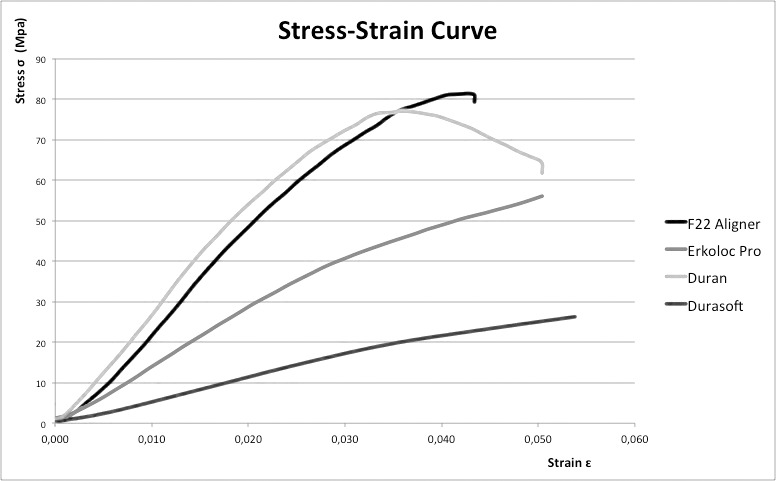
Stress–deformation curve of the of the four selected polymers.
Table 3.
Yield-Strength Testing Results
| Name |
Materiala |
Thickness, mm |
Yield Strength, MPa |
One-Fourth Yield Strength, MPa |
Deflection at One-Fourth Yield Strength, mm |
| F22 Aligner | TPU | 0.75 | 81.36 | 20.34 | 1.26 |
| Duran | PETG | 0.75 | 77.04 | 19.26 | 1.04 |
| Erkoloc-Pro | PETG/TPU | 1 | 31.53 | 7.88 | 1.45 |
| Durasoft | PC/TPU | 1.2 | 27.57 | 6.89 | 1.1 |
TPU indicates thermoplastic polyurethane; PET-G, polyethylene terephthalate glycol-modified; and PC, polycarbonate.
Stress Relaxation Test
The stress relaxation curves for each of the four materials during the 24-hour period are shown in Figure 4a–d, and the mean initial stress, final stress, and stress decay are reported in Table 4. As evident from Figure 4 and Table 4, the F22 Aligner polyurethane presented the greatest absolute initial stress, but also the greatest decay during the 24-hour period. The Erkoloc-Pro had the lowest initial and final stress values, and the smallest variation in stress over time was measured for Durasoft, which decreased from 6.3 MPa to 5.3 MPa in 24 hours.
Figure 4.
(A) Stress relaxation curve: F22 Aligner. (B) Stress relaxation curve: Duran. (C) Stress relaxation curve: Erkoloc-Pro. (D) Stress relaxation curve: Durasoft.
Table 4.
Mean Initial Stress, Final Stress, and Stress Decay
| Name |
σ1, MPa |
σ2, MPa |
Relaxation, MPa (σ1 – σ2) |
| F22 Aligner | 23.7 | 10.7 | 13 |
| Duran | 20.1 | 7.6 | 12.5 |
| Erkoloc-Pro | 5.5 | 4.1 | 1.4 |
| Durasoft | 6.3 | 5.3 | 1.0 |
Table 5 and Figure 5 show the normalized stress values, that is, the percentage stress decay (normalized stress %) during the 24-hour period of observation. All the specimens presented a higher stress relaxation percentage during the first 8 hours under a constant load, and from 16 to 24 hours the percentage of stress relaxation stabilized around a nearly constant plateau. Duran presented the higher percentage of stress relaxation, followed by F22 Aligner. Durasoft was the specimen with the lower percentage of stress relaxation.
Table 5.
Normalized Stress–Relaxation
|
|
Time, ha |
|||
| 0 |
8 |
16 |
24 |
|
| Normalized stress, % | ||||
| F22 Aligner | 100 | 59.5 | 50.2 | 45.5 |
| Duran | 100 | 56 | 45 | 38 |
| Erkoloc-Pro | 100 | 83.9 | 79.8 | 74.5 |
| Durasoft | 100 | 87.3 | 84.1 | 82.1 |
| Stress relaxation, % | ||||
| F22 Aligner | 0 | 40.5 | 49.8 | 54.5 |
| Duran | 0 | 44 | 55 | 62 |
| Erkoloc-Pro | 0 | 16.1 | 20.2 | 25.5 |
| Durasoft | 0 | 12.7 | 15.9 | 17.9 |
h indicates hours.
Figure 5.
Normalized stress curve of the four selected polymers.
DISCUSSION
Our results confirm that the aligners on the market will perform differently in strict relation to their thickness and construction material. Previous three-point bending and nanoindentation tests4 have been used by many researchers to study the stiffness of such materials after in vitro and in vivo wear, highlighting the importance of exerting sufficient force to move the teeth in a programmed fashion but not so much as to damage their periodontal support. However, we are among the first research groups to investigate their stress relaxation properties.
Ideally an aligner should apply a light force that is constant over time. To exert safe but efficacious forces, the ideal material should therefore be fairly stiff with a high yield strength able to ensure that the force is applied within the elastic range. In other words, its relaxation curve should be fairly flat, demonstrating its ability to exert constant and continuous forces over time. Unfortunately, however, none of the four aligner materials we tested demonstrated all of these characteristics.8 That being said, although the thickness of the aligner material has a great influence on the force it develops,4 those in clinical use, whether single- or double-layer, are not all of the same thickness, so we were unable to compare identical samples in this regard.
Nevertheless, to overcome this limitation we performed preliminary yield-strength testing to establish for each specimen a different deflection suitable for the subsequent stress relaxation tests. Via the three-point bending test used for this end, we showed that the single-layer materials (F22 Aligner and Duran) were more than four times stiffer than their double-layer counterparts (Erkoloc Pro and Durasoft; Table 2). This characteristic should be worked out because at the thicknesses marketed today, some aligners may not be able to exert sufficient force to guide the teeth into their programmed positions, or the clinical protocol should be adjusted specifically for this feature.
It is difficult to compare these findings with those of other authors who have used different protocols for their three-point bending tests. For example, Iijima et al.16 also tested PET-G, polypropylene, and TPU with different transition temperatures and at deflection 3 mm, span 12 mm, and sample dimensions 0.5 × 1 × 20 mm. The resulting load–deflection curves were affected by the geometry of the samples, and we therefore decided to evaluate our samples using stress–strain curves because neither stress nor strain are influenced by geometry and therefore provide more useful means of characterizing the materials under investigation.
First and foremost, our stress relaxation tests showed in all samples that stress decay was very rapid during the first 8 hours of application, tending to diminish to a plateau thereafter. This common pattern indicates that the performance of an aligner should be evaluated not only in terms of the force exerted upon insertion but also that expressed 15 to 20 hours later. Indeed, there were remarkable differences in the way the materials behaved during the 24-hour testing period. That with the greatest absolute initial stress value (23.7 MPa) was the F22 Aligner, but 40.5% of this was lost during the first 8 hours, and 54.5% during the entire 24 hours, reaching a plateau at 13 MPa. Even more, Duran released 44% of the initial stress during the first 8 hours, and 62% during 24 hours. At the other end of the spectrum, Erkoloc Pro exhibited the lowest stress values, both at the beginning and at 24 hours (5.5 MPa and 4.1 MPa, respectively), and Durasoft reached a plateau of 5.3 MPa, starting from an initial value of 6.3 MPa and releasing 12.7% during 8 hours and 17.9% during 24 hours (Figure 6).
Figure 6.
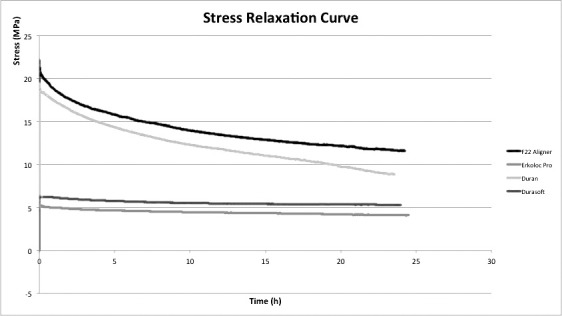
Stress relaxation curve of the four selected polymers.
These findings are partially in line with those in the literature. Indeed, Zhang et al.14 also found a rapid decay in stress during the first 60 minutes of application of the load, as did Fang et al.11 during the 180-minute testing period in all of the samples analyzed. However, ranging between 33.5 and 50% of the initial stress, the stress-release values reported by the latter were larger than those we measured. This discrepancy could be a result of differences in environmental conditions, as Fang's tests were performed in dry conditions at room temperature, which seems to have given rise to greater initial stress and slower, more gradual stress decay than the moist 37°C we used as testing conditions. Indeed, thermoplastic materials are susceptible to temperature-related changes, especially above 37°C,16 and a further decline in their performance will be seen in vivo when subjected to greater thermal and mechanical stresses, not to mention the action of salivary enzymes.
The present study has some limitations. This is an in vitro analysis that assesses the behavior of different aligner materials before the thermoforming phase, and the specimens are not equal in composition and thickness. The study provides basic research indications about the characteristics of the materials that cannot be automatically generalized to orthodontic aligners. The heat treatment to form the aligners could modify point to point the behavior of the specimen. In addition, these characteristics may change during the treatment period as a result of the physical, chemical, and masticatory stress that can occur in the oral cavity. For more accurate clinical indications, further studies directly on the aligners, new and after wear in the oral cavity, are desirable.
CONCLUSIONS
The thermoplastic materials on the market have very different mechanical characteristics. Of the four types tested, the single-layer samples (Duran and F22 Aligner) were of far greater stiffness than the double-layer samples (Erkoloc Pro and Durasoft).
All materials tested showed significant stress decay during a 24-hour period, from a greater initial stress during the first 8 hours after loading the values to a decrease and a plateau.
The F22 Aligner yielded the greatest initial stress values, but also a high velocity of decay (54.5% in 24 hours).
Duran presented the higher velocity of stress relaxation (62% in 24 hours).
Durasoft presented the smallest decay, falling to 17.9%, but started with very low initial stress values, only slightly above those of Erkoloc-Pro.
Further studies after in vivo aging are required to elucidate the real-world behavior of orthodontic aligners during the course of treatment.
ACKNOWLEDGMENT
Special thanks to Dr Maianna Ceci for her help in performing the stress-relaxation tests.
REFERENCES
- 1.Rosvall MD, Field HW, Ziuchkovski J, Rosenstiel SF, Johnston WM. Attractiveness, acceptability, and value of orthodontic appliances. Am J Orthod Dentofacial Orthop. 2009;135:276–288. doi: 10.1016/j.ajodo.2008.09.020. [DOI] [PubMed] [Google Scholar]
- 2.Boyd R, Miller RJ, Vlaskalic V. The Invisalign system in adult orthodontics: mild crowding and space closure cases. J Clin Orthod. 2000;34:13–15. [Google Scholar]
- 3.Kim TW, Echarri P. Clear aligner: an efficient, esthetic, and comfortable option for an adult patient. World J Orthod. 2007;8:13–18. [PubMed] [Google Scholar]
- 4.Kohda N, Iijima M, Muguruma T, Brantley WA, Ahluwalia KS, Mizoguchi I. Effects of mechanical properties of thermoplastic materials on the initial force of thermoplastic appliances. Angle Orthod. 2013;83:476–483. doi: 10.2319/052512-432.1. [DOI] [PMC free article] [PubMed] [Google Scholar]
- 5.Align Technology, Inc. INVISALIGN® introduces SmartTrack. Available at: http://invisalign.com.au/doctor/doc/brochures/SmartTrack_brochure.pdf.
- 6.Dupaix RB, Boyce MC. Finite strain behavior of poly(ethylene terephthalate) (PET) and poly(ethylene terephthalate)-glycol (PETG) Polymer. 2005;46:4827–4838. [Google Scholar]
- 7.Guarneri MP, Lombardo L, Gracco A, Siciliani G. The State of the Art of Clean Aligner Technique [in Italian] Bologna, Italy: Martina Editor; 2013. 15–24. [Google Scholar]
- 8.Ren Y, Maltha JC, Kuijpers-Jagtman AM. Optimum force magnitude for orthodontic tooth movement: a systematic literature re-view. Angle Orthod. 2003;73:86–92. doi: 10.1043/0003-3219(2003)073<0086:OFMFOT>2.0.CO;2. [DOI] [PubMed] [Google Scholar]
- 9.Lombardo L, Marafioti M, Stefanoni F, Mollica F, Siciliani G. Load deflection characteristics and force level of nickel titanium initial archwires. Angle Orthod. 2012;82:507–521. doi: 10.2319/032511-213.1. [DOI] [PMC free article] [PubMed] [Google Scholar]
- 10.Lombardo L, Toni G, Stefanoni F, Mollica F, Guarneri MP, Siciliani G. The effect of temperature on the mechanical behavior of nickel-titanium orthodontic initial archwires. Angle Orthod. 2013;83:298–305. doi: 10.2319/040612-287.1. [DOI] [PMC free article] [PubMed] [Google Scholar]
- 11.Fang D, Zhang N, Chen H, Bai Y. Dynamic stress relaxation of orthodontic thermoplastic materials in a simulated oral environment. Dent Mater J. 2013;32:946–951. doi: 10.4012/dmj.2013-131. [DOI] [PubMed] [Google Scholar]
- 12.Kravitz ND, Kusnoto B, BeGole E, Obrez A, Agran B. How well does Invisalign work? A prospective clinical study evaluating the efficacy of tooth movement with Invisalign. Am J Orthod Dentofacial Orthop. 2009;135:27–35. doi: 10.1016/j.ajodo.2007.05.018. [DOI] [PubMed] [Google Scholar]
- 13.Schuster S, Eliades G, Zinelis S, Eliades T, Bradley TG. Structural conformation and leaching from in vitro aged and retrieved Invisalign appliances. Am J Orthod Dentofacial Orthop. 2004;126:725–728. doi: 10.1016/j.ajodo.2004.04.021. [DOI] [PubMed] [Google Scholar]
- 14.Zhang N, Bai Y, Ding X, Zhang Y. Preparation and characterization of thermoplastic materials for invisible orthodontics. Dent Mater J. 2011;30:954–959. doi: 10.4012/dmj.2011-120. [DOI] [PubMed] [Google Scholar]
- 15.Wineman AS, Rajagopal KR. Mechanical Response of Polymers. Cambridge University Press; Cambridge, UK: 2000. 67–72. [Google Scholar]
- 16.Iijima M, Kohda N, Kawaguchi K, et al. Effects of temperature changes and stress loading on the mechanical and shape memory properties of thermoplastic materials with different glass transition behaviors and crystal structures. Eur J Orthod. 2015;37:665–670. doi: 10.1093/ejo/cjv013. [DOI] [PubMed] [Google Scholar]



